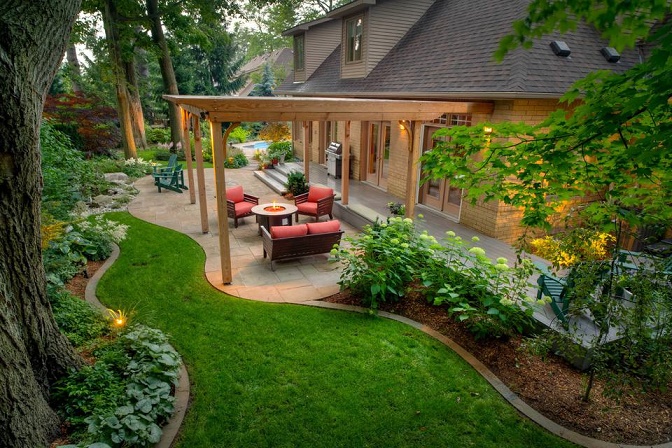
Designing a backyard depends on how you want it to look and meet your needs. You may already have various ideas and concept designs in mind. Nevertheless, it all boils down to your want to make your backyard cozy and functional.
It’s important, however, to note that when designing your backyard you should take into consideration your outdoor space and terrain. If you aren’t confident with your DIY skills, it’s wise to consult landscape contractors who can help you create or refurbish your outdoor space properly.
In this article, you will learn the 5 steps to design your backyard—so read on!
#1 Pathways
Building a pathway is necessary especially if you have a garden, patio, and pool in your yard. This will help you and your guests to navigate through it easily and without getting dirty. There are various affordable materials that you can use in constructing your pathway, such as:
- Gravel– such as crushed gravel, crushed limestone, crushed stone, and pea rock. These are cheap gravel for the pathway that you can easily purchase in your area and if that is too long you can just highlight cheap gravel for the pathway. Aside from being inexpensive, it’s also durable, easy to maintain, and cannot be washed away.
- Mulch – are cheaper and lighter than stone and can be spread and hauled easily. Wood chips, cocoa beans, and cypress bark are the common kinds of mulch. However, organic paths perish over some time. Thus, you need to replenish them every two to five years. Moreover, if you have a poor drainage system in your yard do not use mulch as your path.
- Stepping-Stone Paths with Yard Stones – are considered faster and easier to build. Although, the stones are heavy and require digging, yet it’s cheaper and also durable.
Similarly, bordering and edging are important when building a pathway to prevent the material from being blown away into your lawn or flower bed. There are several types of cheap edging such as plastic landscape edging, steel or aluminum edging, brick and stone borders, concrete edging, and landscape timbers.
#2 Patios
Patios are a functional addition to your backyard. However, building patios depends on the size of your backyard and the budget that you are willing to spend. When planning to construct a patio, consider these:
- Choose a place – A patio shouldn’t always be adjacent to the house. You can build it further making it good for a private retreat. However, if you want your patio as a dining area, it should be near the kitchen as much as possible.
- Have the right size – The patio’s size depends on its use and purpose. If it’s for family, make the size enough to serve the needs of your family members. If it’s for future gatherings you’ll need a bigger one to accommodate a larger crowd.
- Pick a material – For patio floorings, the common materials used are brick, concrete, slate, and flagstone. It can be alone or a combination of any of the materials and should match the style of your home.
- Select details – A patio can be as simple as a piece of concrete. But it can also be complex—loaded with various amenities such as low-voltage lighting, planters, fountains, or fireplaces.
- Plan your plantings – The presence of trees, flowers, and shrubs add beauty and attraction to your patio. However, make sure that it will complement instead of overwhelm the space.
Also Read: How to Decorate a Small Patio Space
#3 Trees
Once your pathways and patio are in place. You can start planting trees that thrive well in your area. Trees serve as your best shade and backdrop for your patio, pool, or entire backyard. Trees add beauty and serve as a habitat for local wildlife.
However, if their branches reached your roof and power lines then it’s best to trim them down. If you feel you have to remove it, be sure to use a tree removal company.
#4 Plants
Adding plants into your backyard should be properly planned for it to look appealing and harmonious. Otherwise, they will look like background noise or an overwhelming, unnecessary element.
The first step to designing your landscape is to select a focal point.
After exploring your focal point, start planting bigger plants first then smaller ones. Try to look into specifics before planting any kind of plant, such as shrubs and flowers to maintain the best results possible.
Shrubs should be planted near your house but they should be lower than your window when fully grown. Subsequently, flowers, taller shrubs, and other colorful plants should be placed on the exterior and serve as a backdrop.
#5 Gardens
Introduce a flower garden in your yard and it will add color and impact to your backward. Small roses are a very popular option when it comes to making a garden out of flowers, you can read on www.lamouretfleurs.com blog. While your gardening experience and budget will be put to test here—it’ll be a worthy addition to your yard.
Your garden can be anything from simple to complex. Simple plants require low-maintenance care such as perennial plants that keep on coming back year after year. You can also try having an edible garden. If you are considering a particular garden style like a traditional landscape design, this may cost more and may require higher maintenance.
Building a garden shed is also a great idea to spice up your backyard. You can use it as a functional space, such as an outdoor office space or a storage space.
Some instant lawn for landscapers is another option you might consider.